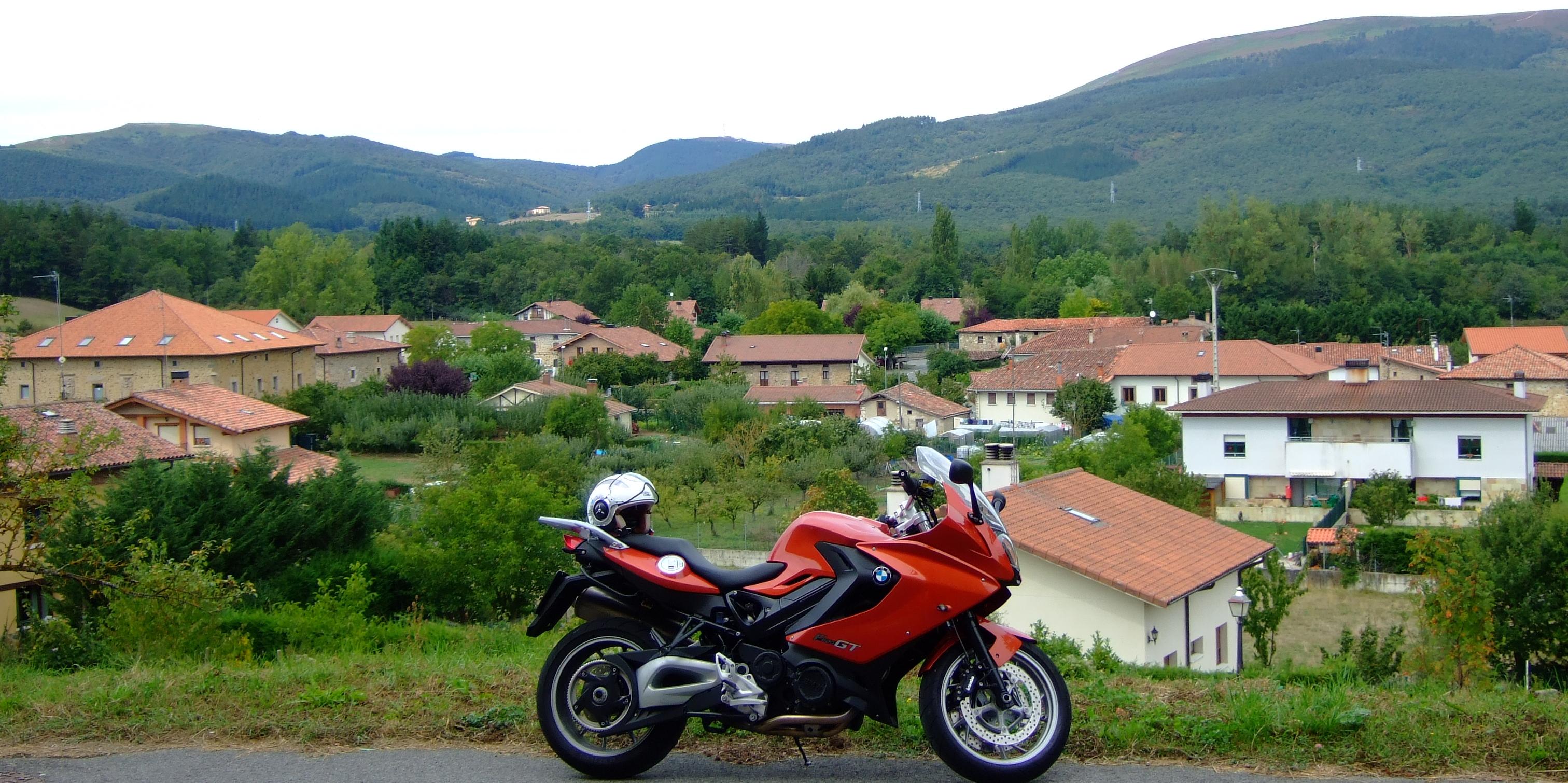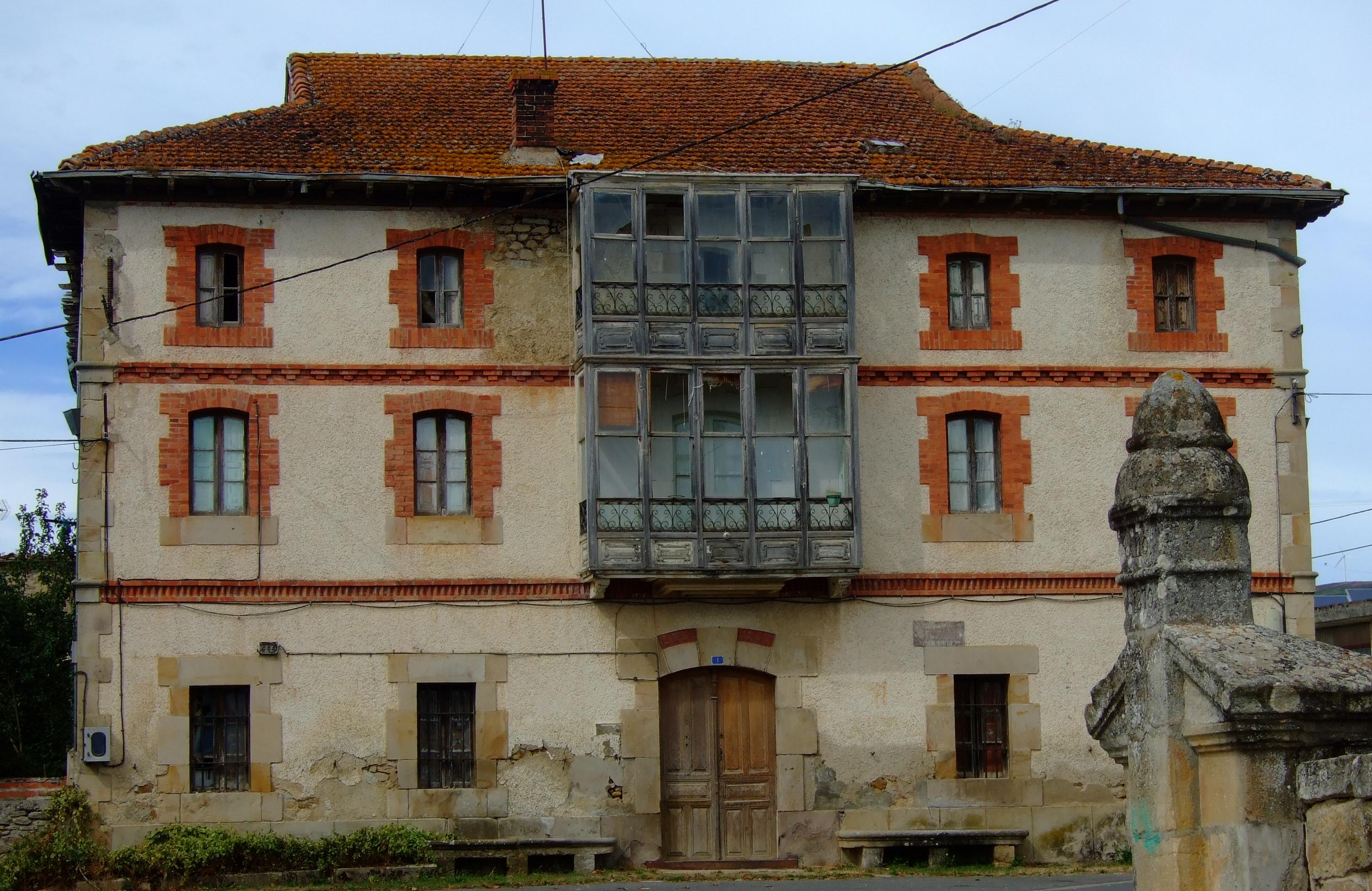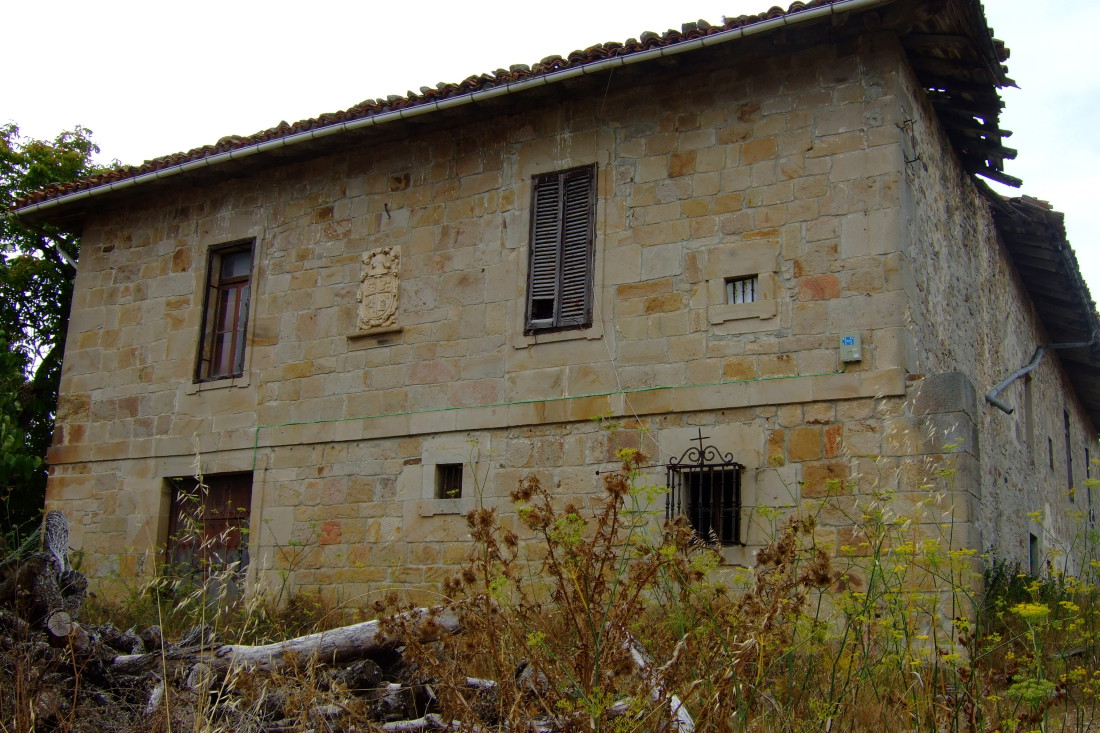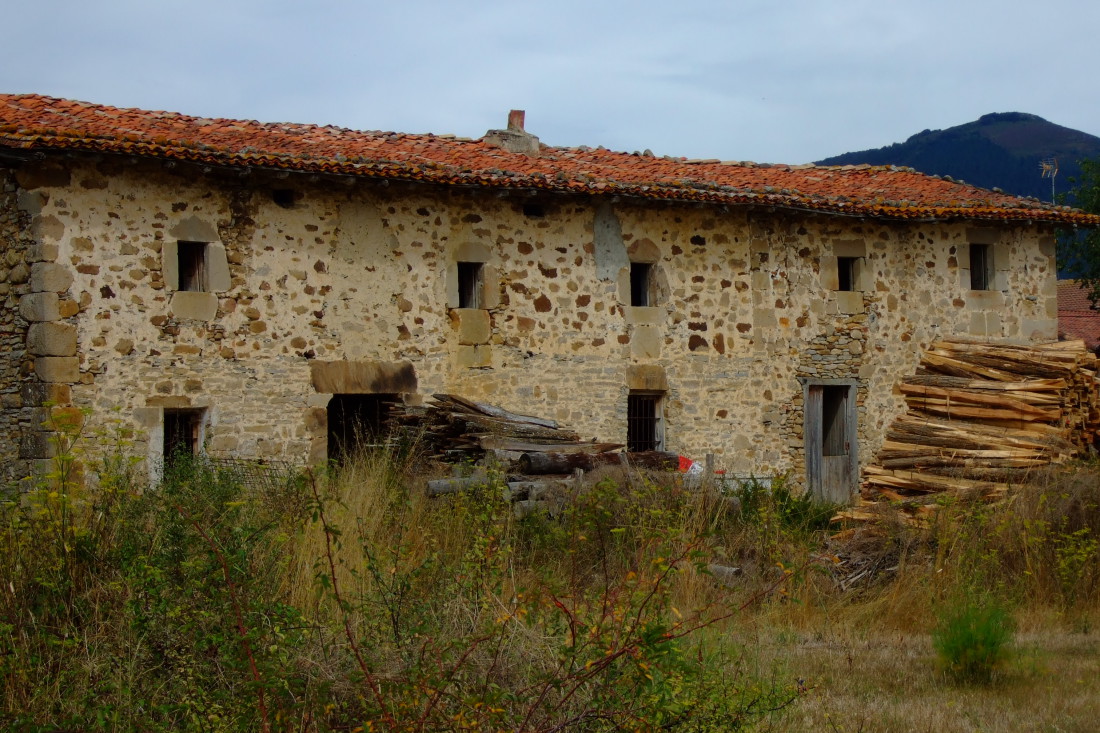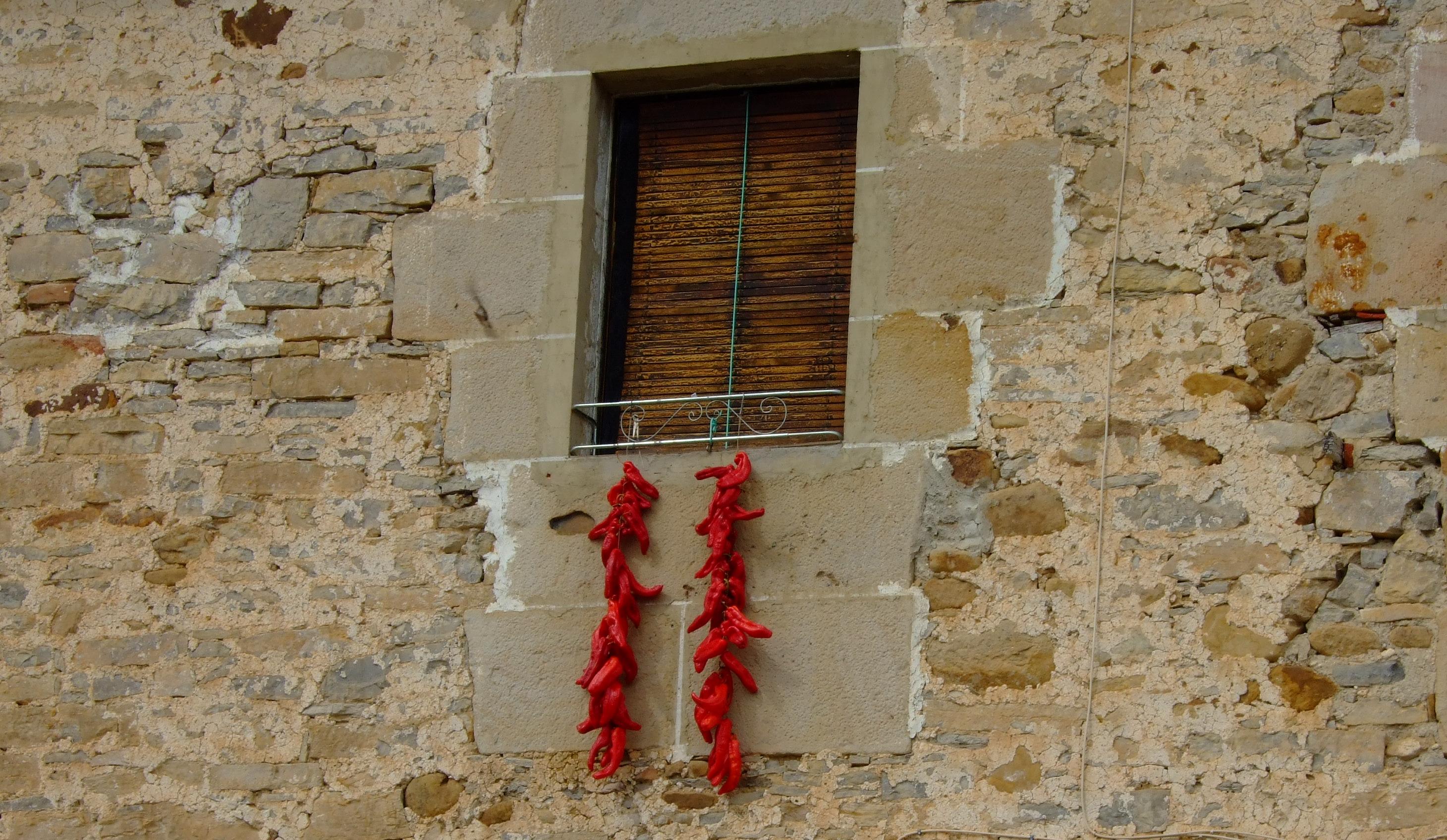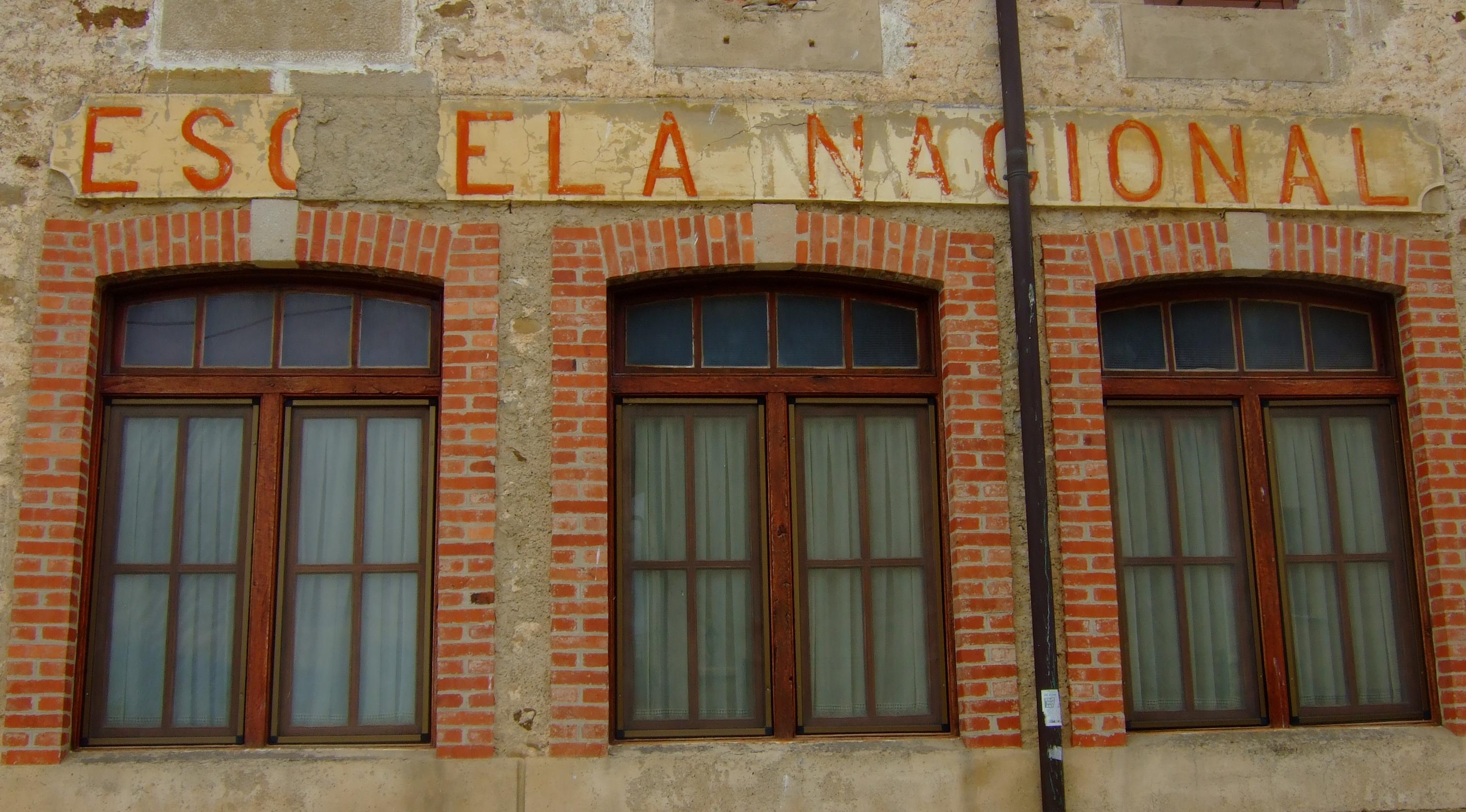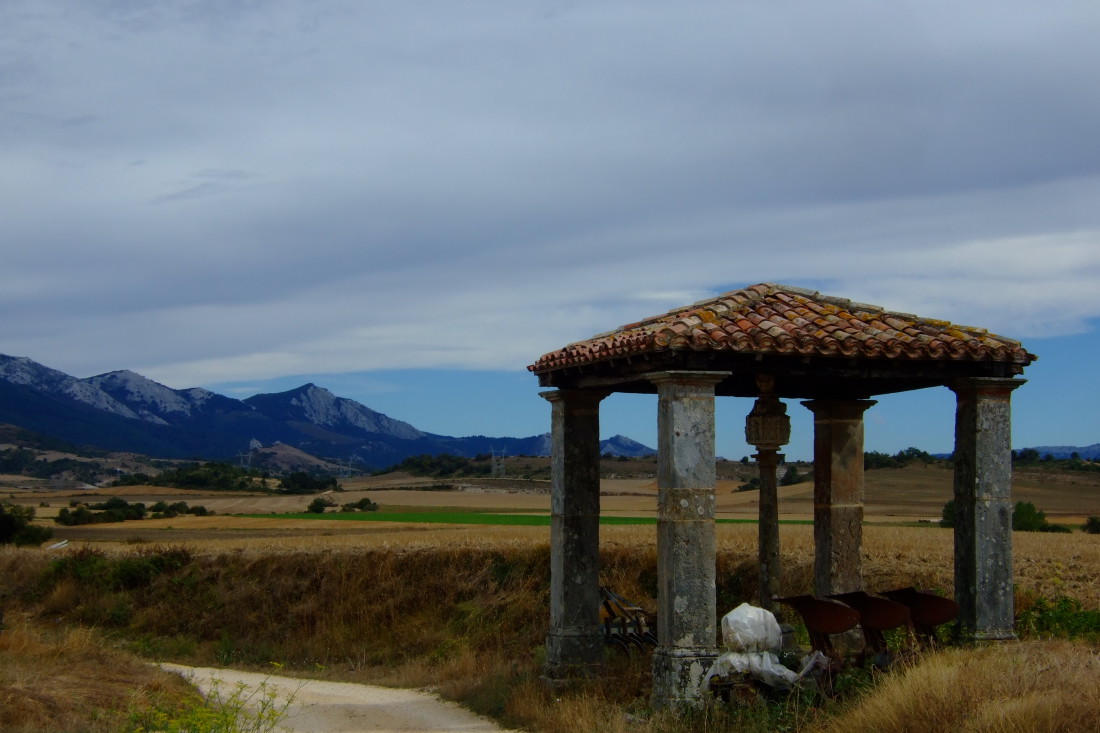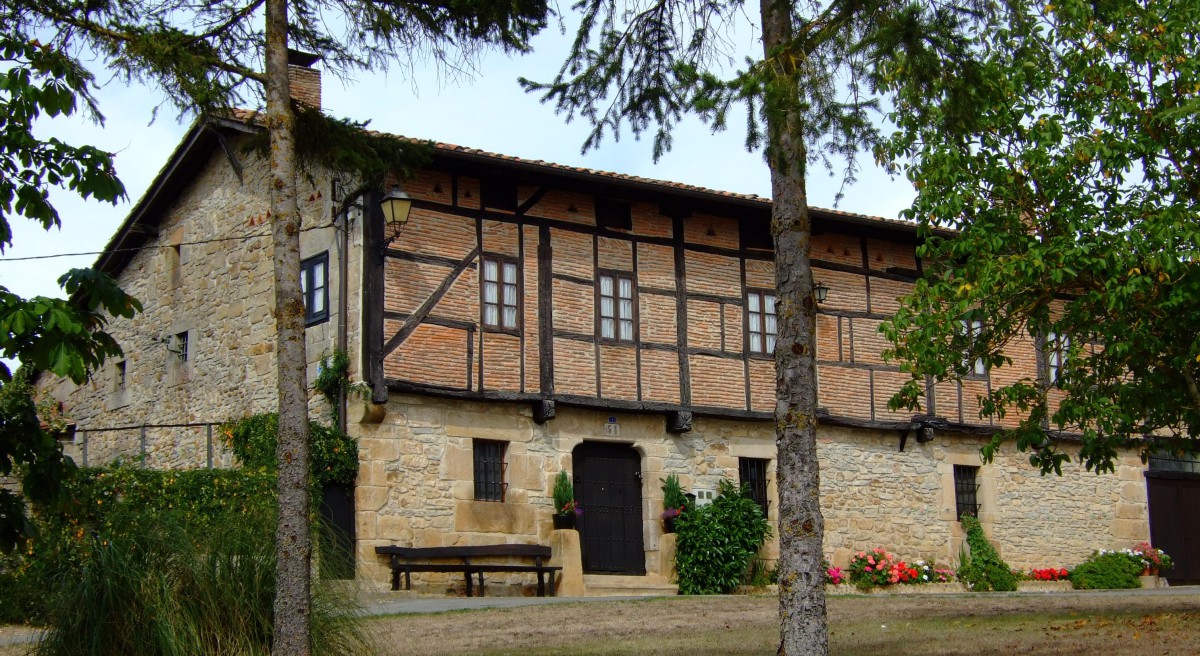.
El otoño se abre temprano camino en la llanada alavesa, tiñendo de siena las hojas de los árboles; pronto – el fin de semana menos pensado – montar en moto por estas tierras no será una experiencia tan placentera como ahora. Agarro una cazadora ligera y el casco jet, echo un vistazo al mapa, otro al cielo, y saco a Rosaura de paseo. Vamos a visitar la que, durante siglos, fuera Leal Villa de Salvatierra.
Pese a que algunas nubes altas enturbian el azul celeste y afean los colores de la tierra, el aire se siente tibio y agradable. Da gusto.
Doy un rodeo por el embalse de Ullibarri para entretenerme un poco con las ágiles y conocidas curvas de la carretera que lo bordea, frecuente ruta de domingueros y motoristas. La primera parada, obligada, la hago en el Etxe-Zuri, lugar de encuentro de unos y otros. Más que invitado me siento compelido a parar, cuando veo la media docena de motos en batería, como monturas en un pesebre, que se exhiben en el aparcamiento. Rosaura no desentona. Hay en la terraza un grupo de moteros carbonilla dándose un festín, y supongo que serán suyas las cabalgaduras de horquilla delantera invertida.
Un generoso pincho de tortilla y una sidra me sirven de almuerzo. Algunos rayos de sol que se cuelan por entre los altocúmulos me calientan el cuerpo y me reconfortan el alma. Me gusta la costumbre vascongada de pedir en la barra y sentarse luego a una mesa, sin la presión (ni el recargo) de los camareros de terraza. Aquí no hay dos precios, como en muchas otras partes de España. Te sirven, pagas, y tomas tu consumición donde te parezca.
Al acabar, monto y enfilo la carretera que discurre a lo largo del templado y fértil valle del Barrundia, protegido de los fríos vientos del norte por la sierra de Urquilla, moteado de aldeas entre los sembrados y las arboledas; aldeas que han perdido, en gran parte, su sabor de antaño a causa de las urbanizaciones que casi todas albergan: el amable clima y la cercanía a la capital hacen de este valle objetivo idóneo para una segunda vivienda. Los prados están llenos de sanas y ubérrimas vacas lecheras. Lástima que la industria láctea regional esté secuestrada por una política de inmersión cultural que les impide colocar mejor la rica y espumosa leche que aquí se produce.
Cautivado por el gallardo perfil de su iglesia sobre una loma hago una parada en Ozaeta. Bajo el pórtico, un grupo de chavales beben y charlan en español. A lo largo del costado sur de la iglesia está el típico bolatoki.
Unos kilómetros más adelante llego a Narbaiza (o Narvaja), y esta vez es la triste casona abandonada de algún indiano, junto a la carretera, lo que me hace detenerme. Cerrada la recia puerta de doble hoja, ajada y cenicienta la madera de ventanas y galerías, rotos algunos vidrios, llenas las paredes de desconchones, desdentado el alero de los tejados, es en verdad el nostálgico recordatorio de un tiempo que ha poco se ha ido para siempre. Un cartel de “se vende” rubrica el triste destino de estas construcciones que un día se erigieron con orgullo y quizá rebosaron de vida.
Me doy un paseo por la aldea, que parece como desierta; no se oye un ruido ni se mueve un matojo. Me gusta colarme en los pueblos cuando sestean porque el recogimiento en que se sumen me permite captar mejor su esencia y deja el campo abierto a mi imaginación. En un extremo de Narvaja se erige otro testigo de un pasado mucho más remoto y decadente aún: la casa semiarruinada de alguna noble familia, invadida por los yerbajos, hundida la techumbre a trozos, tuerta de celosías, exhibiendo aún en la fachada un escudo de armas que ya a nadie importa. El brillante canalón del alero atestigua el estéril esfuerzo de algún último heredero por evitar la ruina del edificio. En los valores de la vida moderna ya no hay lugar para estas mansiones; otras son las prioridades del dinero.
Entretanto, en otros rincones de la aldea, se hace acopio de leña para el invierno y se ponen a secar las ristras de pimientos en las ventanas que dan al sur.
Al doblar una esquina me encuentro con una tercera reliquia del pasado, este no tan remoto: el viejo letrero de una escuela en los tiempos de la dictadura, milagrosamente respetado por la fiebre antifranquista. No era yo tan niño cuando aún se daban clases en estos sobrios edificios que tan severísima educación cobijaron.
Atravesando un rastrojo me encuentro con esta curiosa construcción, que no sé lo que es. Parece un cruceiro gallego, pero lo que alberga no es una cruz. Cualquiera que fuese su objeto original, hoy día sólo sirve para que algún campesino guarezca las rejas de su arado.
Ya de regreso para continuar mi viaje, me doy cuenta de que he aparcado la moto cerca de una bonita y rica casona, seguramente rehabilitada. Me resulta curioso el contraste con las otras que he visto en la aldea. Estos son los nobles y los indianos de ahora. Cambian las modas y los estilos, pero donde hay buen gusto siempre se nota.
Comienza el sol a declinar hacia poniente y continúo yo mi camino hacia oriente. En esta época del año, es la mejor hora del día para la moto, y puedo incluso prescindir de la cazadora. Conduzco sin prisa, mirando todo a mi alrededor; llevo la visera levantada y la postura erquida, recibiendo de lleno el cálido aire de la tarde.
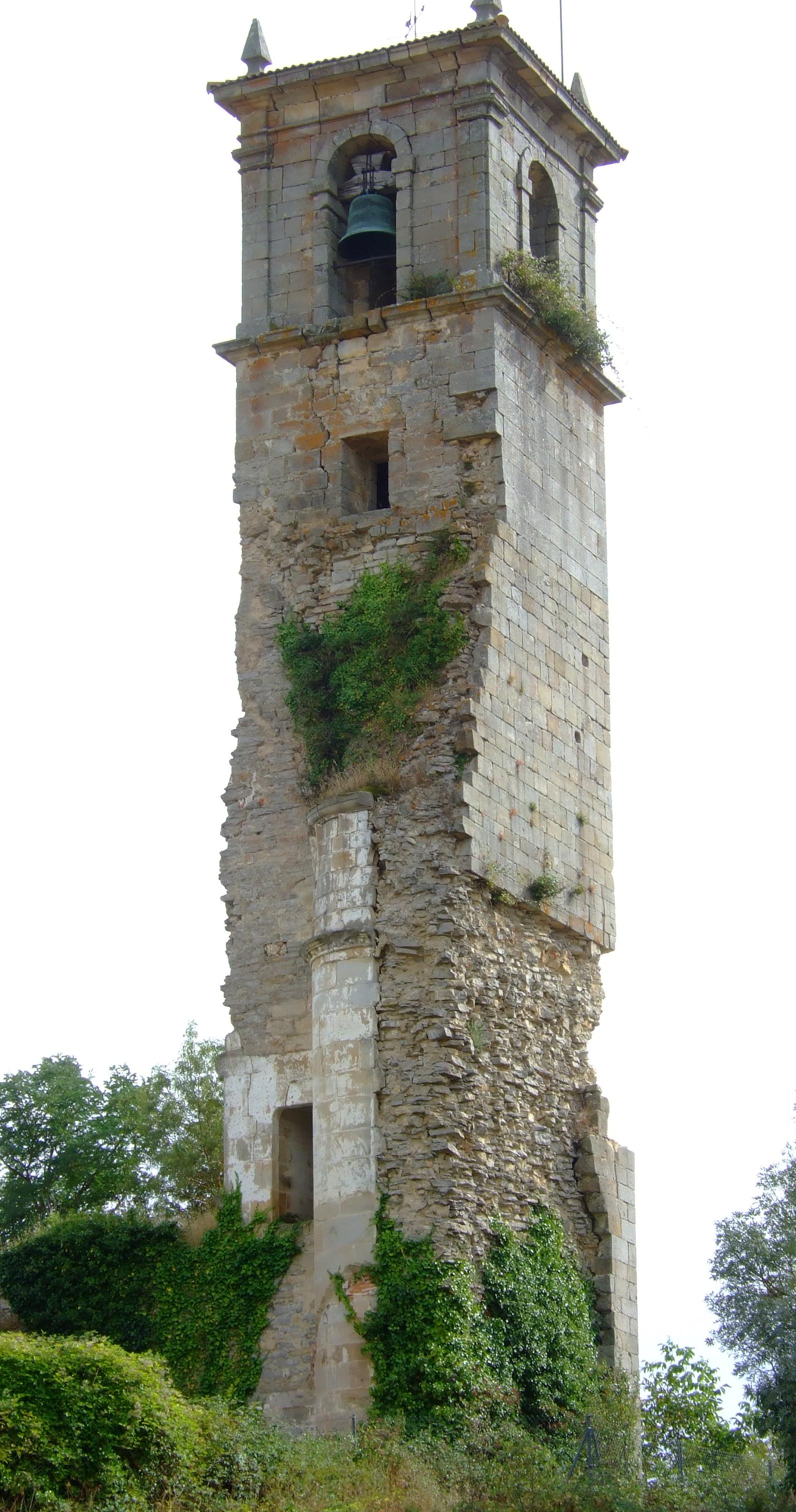
Desde Narbaiza ya destaca contra el cielo el maltrecho campanario, medio conquistado por la hiedra, de la iglesia en ruinas de Galarreta. Apenas queda nada más de ella, salvo el trozo de muro en que estaba la puerta, con una curiosa decoración que recuerda a la grecia antigua. Y como el hombre es un animal de rapiña, al torreón le faltan los sillares hasta media altura; es de suponer que, tras el derrumbe de la iglesia, los lugareños los saquearon para construir sus casas.
Meditando sobre estos viajes caigo en la cuenta del asombroso esfuerzo constructor de la Iglesia Católica: no hay en zona cristiana aldea, ciudad o población, por pequeña que sea, que no tenga su ermita o su parroquia, su catedral o su iglesia, cuando no son varias o muchas. Me admiran la energía, la tenacidad y constancia con que, durante ya dos milenios hace, se erigen estas construcciones, recias, duraderas y costosas. Sólo la fe o la ambición, mantenidos siglo tras siglo, pueden haber impulsado ese esfuerzo; que ha hecho, por cierto, de España lo que es y de los españoles lo que somos, nos guste o no.
Y antes de girar hacia el sur en busca de Salvatierra hago la última parada en este valle: Zalduendo, hito jacobeo de la ruta secundaria a Santiago y villa que fuera señorío de la casa de Oñate durante más de cuatro siglos, hasta el 1813. Un pueblo que, desde que dejo a Rosaura bajo el enorme árbol junto a la fuente, me cae bien por la afabilidad que muestran sus habitantes: todos me saludan, amistosos; cosa que resulta extraña en esta Vasconia de gente noble pero adusta. Tal vez sea porque Zalduendo es Castilla; o al menos así lo siente al visitante: no se escucha el vascuence por la calle, no hay etxeras en los balcones, y en el ayuntamiento ondea, junto a la inkurriña, la bandera rojigualda.
Me acerco hasta la iglesia, que está abierta porque dos señoras están de limpieza y cambiando las flores. Les pido permiso para asomarme y asienten con simpatía. Una de ellas entra en pos de mí y me ofrece encender las luces para que pueda contemplar mejor el retablo. Lo encuentro muy normalito, así que le miento cuando me pregunta qué me ha parecido. ¡Se la ve tan ufana!
Es un pueblo muy cuidado, de bonitas casas tradicionales y bien restauradas, donde no veo ninguna que ponga la nota discordante. Destaca en el núcleo central el palacio de Lazárraga que, con su impresionante y algo sobrecargado escudo de armas, hace de museo local. Por último, entro al bar y entablo charla con la dueña. Tienen la prensa de Navarra y me explica: es que estamos junto al límite provincial. Pido una Cocacola. Se está bien allí, leyendo el periódico; ha salido el sol un momento y entra alegre por el amplio ventanal.
Es hora de seguir ruta, así que vuelvo a la fuente, monto en la BMW y me encamino al último punto de mi itinerario: Salvatierra. Pero de eso hablaré en el próximo capítulo.
..
Fall makes an early way into the Álava plain, tinging the trees with sienna shades; soon – any of these weekends – riding a motorcycle around here won’t be so pleasurable as now. One ougth to make the best of the last warm days. So, I grab a light jacket and my jet helmet, take a look at the map, a glance at the sky, and Rosaura for a ride, east along the Cuadrilla de Salvatierra (cuadrilla being a group of villages, something like a county) with final destination the Loyal borough of Salvatierra.
It’s a fine day and, despite some high clouds covering the azur and toning down the landscape, the air feels tepid and pleasant.
I make a detour around Ullibarry reservoir for the fun of taking the bends of its skirting road, popular among Sunday drivers and bikers. The first must-stop is the Etxe-Zuri restaurant meet point. The sight of half a dozen motorcycles parked abreast, like horses in a manger, calls me to a halt. Rosaura is not out of place. There’s a group of bikers eating at a table in the terrace, whose are the racing bikes in the paking, I guess.
A fair pincho de tortilla and a glass of cider make my lunch. A few sunbeams breaking through the clouds warm my body and soothe my soul. I like the Basque ways: your order at the bar and then sit at a table, without the hassle (and the surcharge) of terrace waiters. There are no “terrace price” and “bar price” like in most of Spain. You’re served, you pay, then you eat wherever you see fit.
Once I’m done, I get on my BMW and head for the road running along the mild and fertile Barrundia valley, sheltered from the cold northly winds by the Urquilla range and spotted with boroughs among the pastures and groves; boroughs that lost their charm of yore as they’ve become residential areas of the capital: with a gentle climate and neighbouring Vitoria, this valley is suitable for a second home. There are plenty of sound and productive milk cows in these fields. Pity that the Basque dairy industry is kidnapped by a cultural immersion policy that hampers a better market for the rich and foamy milk produced here.
Attracted by the fine profile of a church on a hillock, I make a halt in Ozaeta. A group of youngsters drink and talk in Spanish under the church’s portico, and along its south side, under a colonnated hallway I find the customary bolatoki.
A few kilometres further I come to Narbaiza (or Narvaja). What makes me stop this time is the withered look, by the road, of an abandoned house of some indiano (the Spaniards who made good in the Americas during XIXth and XXth centuries). Locked the sturdy door, worn out and ashy the wood of windows and balconies, broken some panes, stripped off the walls, untiled the roof eaves – it’s certainly the nostalgic reminder of a time gone forever. On its side, a sign saying “for sale” certifies the sad fate of these house, once built with pride and filled with life.
I take a stroll in the deserted looking borough; not a leave moves nor a sound can be heard. I like to steal into the napping villages because the quiet lets me better catch their essence, and lets my imagination free. In a corner of Narvaja stands another witness of a much further-off and decaying times: the half wrecked house of some nobleman, encroached upon by weed, the roof partly caved in, fallen the slatter shuters, yet showing upon the facade of stone an uncared for coat of arms. The shiny gutter in the front tells of the futile attempt by some last heir to prevent the utter ruin of the building. But in present day values there is no room any more for these palaces; money has different priorities now.
Meanwhile, in some other places of the village, people pile up wood for the winter, and the strings of red pepper are set to dry on the south windows.
Upon turning a corner I come across a third relic of the past, not so distant this time: the old sign of a national school during our last dictatorship, miraculously respected by the later anti-Franco frenzy. I wasn’t that young when classes were still taken within these sober buildings, which harboured such a rigid education system.
Beyond a stubble field I find this interesting old construction, whose purpose I ignore. Whichever it was, now it’s only good for sheltering a peasant’s ploughshare.
When I get back to keep my journey I realize that I parked Rosaura by a fine and rich house, probably restored. What a contrast it makes with the other two houses mentioned! These are the noblemen of modern times. Fashion and style change along time, but there is always people with a good taste.
Sun starts its way down to westerly and I retake my way to easterly. Now is the best hour for biking this time of the year, and I can even do without the jacket. I ride rushless, watching all around me; the trunk erect, the helmet’s visor lifted, taking all the warm air of the afternoon.
 From Narbaiza one can already see the battered bell tower of Galarreta‘s church remains, standing out, won over by the ivy. Almost nothing else is left except the wall which held the gate, with an interesting decoration reminding of ancient Greece. And, as such is mankind, the tower has been pillaged the ashlars by the locals for building their houses. Who cares about historical remains in Spain?
From Narbaiza one can already see the battered bell tower of Galarreta‘s church remains, standing out, won over by the ivy. Almost nothing else is left except the wall which held the gate, with an interesting decoration reminding of ancient Greece. And, as such is mankind, the tower has been pillaged the ashlars by the locals for building their houses. Who cares about historical remains in Spain?Pondering these weekend breaks of mine I realize the astonishing construction vigour of the Catholic Church: in Christian land there is no village or town, city or borough, however small, lacking a church or cathedral, chapel or shrine. I’m amazed by the energy and perseverance with which such sturd constructions are erected since two thousand years, despite the cost. Only faith or ambition, kept for centuries in a row, may have powered such spirit; which, by the way, has made Spain what it is now, and Spaniards what we’re now, like it or not.
And, right before turning south towards Salvatierra, I make a last stop in this valley: Zalduendo, standing upon a secondary route to Santiago, a borough that was for longer than four centuries feudal estate of the Oñate house, until 1813. Un borough that I fancy from the first moment, since I park Rosaura under the huge tree by the fountain: people are genial, and every person I come across say hi to me; which is rather unusual in this Basque country, whose people are usually courteous but sullen. But, despite belonging to Baskonia, Zalduendo is Castile, or so it feels: you can’t hear Basque spoken, nor see etxeras (logo-flags pro terrorist inmates’ rights), and the city hall shows the Spanish flag.
I go to the church, open by chance: two ladies are cleaning and changing the flowers. I step in and they smile to me, offering to switch on the lights for letting me better see the altarpiece. I find it quite standard, so I don’t tell the truth when they ask me how did I like it. They look so proud of it..!
Zalduendo is very tidy, with nice traditional houses finely refurbished, none of them clashing. The big palace of Lazárraga stands out in the middle, boasting a overelaborated coat of arms; it’s now the local museum.
Lastly I go to the bar and chat for a while with the owner about some trifles. I feel well here, reading the paper, the sun merrily shining through the window panes…
But it’s time to go. I go back to the fountain, get on my BMW and make for the last stop in my itinerary: Salvatierra. I’ll tell you about that in the next chapter.

